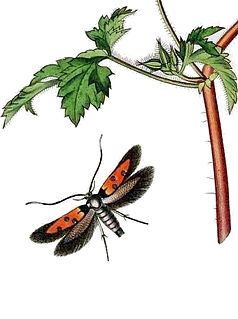
The Agonoxeninae are a subfamily of moths.

Gelechioidea is the superfamily of moths that contains the case-bearers, twirler moths, and relatives, also simply called curved-horn moths or gelechioid moths. It is a large and poorly understood '"micromoth" superfamily, constituting one of the basal lineages of the Ditrysia.
The Cosmopterigidae are a family of insects in the order Lepidoptera. These are small moths with narrow wings whose tiny larvae feed internally on the leaves, seeds, stems, etc. of their host plants. About 1500 species are described. The taxonomic family is most diverse in the Australian and Pacific region with about 780 species.

The Momphidae, or mompha moths, is a family of moths with some 115 described species. It was described by Gottlieb August Wilhelm Herrich-Schäffer in 1857. These moths tend to be rather small with a wingspan of up to 21 mm. The wings are held folded over the body at rest. The larvae are concealed feeders, either as leaf miners or within seeds or stems.

Trachydora pygaea is a species of moth of the family Cosmopterigidae. It is found in Australia.

Eteobalea intermediella is a moth of the family Cosmopterigidae. It is native to an area ranging from Central and Southern Europe, east to the Caucasus, Asia Minor, the Near and Middle East towards Central Asia. It is also present in North Africa. It has been introduced to the United States and Canada.
Ascalenia is a genus of moths in the family Cosmopterigidae.
Asymphorodes is a gelechioid moth genus in subfamily Agonoxeninae of the palm moth family (Agonoxenidae), whose taxonomic status is disputed. Alternatively, the palm moths might be a subfamily of the grass-miner moth family (Elachistidae), with the Agonoxeninae becoming a tribe Agonoxenini.
Neomariania is a genus of moths in the family Stathmopodidae described by Mario Mariani in 1943, although it is sometimes included in the family Cosmopterigidae.

Pyroderces is a genus of cosmet moths. It belongs to subfamily Cosmopteriginae. Some authors include Anatrachyntis here.
Scaeosopha is a genus of moths in the family Cosmopterigidae.
Eteobalea sumptuosella is a moth of the family Cosmopterigidae. It is found in the Mediterranean Region from Spain to Turkey, Morocco and Tunisia, Ukraine, southern Russia, the Caucasus, the Middle East, eastwards to Kazachstan, Turkmenistan and Afghanistan.

Pebobs is a genus of moths in the family Cosmopterigidae.
Bifascioides leucomelanella is a moth in the family Cosmopterigidae. It is found in Libya, Egypt and on Malta. It has also been recorded from Sudan, Iran, Saudi Arabia and the United Arab Emirates.

Pyroderces argyrogrammos is a moth in the family Cosmopterigidae. It is found from central Europe south to the Mediterranean area, the Canary Islands, North Africa, the Middle East, Central Asia and China. It has recently also been recorded on the Channel Islands.
Eteobalea dohrnii is a moth in the family Cosmopterigidae. It is found in France, Spain, Portugal, Italy, Sardinia, Corsica, Sicily, Malta, Croatia, Greece, Crete and Cyprus. In the east, the range extends to Syria.

Stagmatophora wyattella, or Wyatt's stagmatophora moth, is a moth in the family Cosmopterigidae. The species was first described by William Barnes and August Busck in 1920. It is found in the US states of Maine, Ohio, Iowa, Kentucky, Michigan, Mississippi and Oklahoma.

The Antequerinae are a subfamily of the Cosmopterigidae. In the Nearctic, the subfamily consists of eight species in four genera, found in North America and England.









